Introduction
In thirty years, from her first dreadnought battleship, Courbet, started late, in 1910 to the Jean Bart and Gascogne project in 1940, France only had produced four classes of battleships, the Courbet, Bretagne, Dunkerque, and Richelieu, transitioning from dreadnought to super dreadnought, and semi-battlecruiser to fast battleship, respectively. Each iteration brought innovations in concept and design. In 1939, the French capital ship force was in Europe only second to Great Britain, dwarfing the Kriegsmarine and a serious threat to the Regia Marina in the Mediterranean. The defeat on land, soon after Italy declared on France in June 1940, put forward the question of its fate. Churchill was certainly not at ease thinking what the Germans could have done with the Richelieu, or complete the Jean Bart.
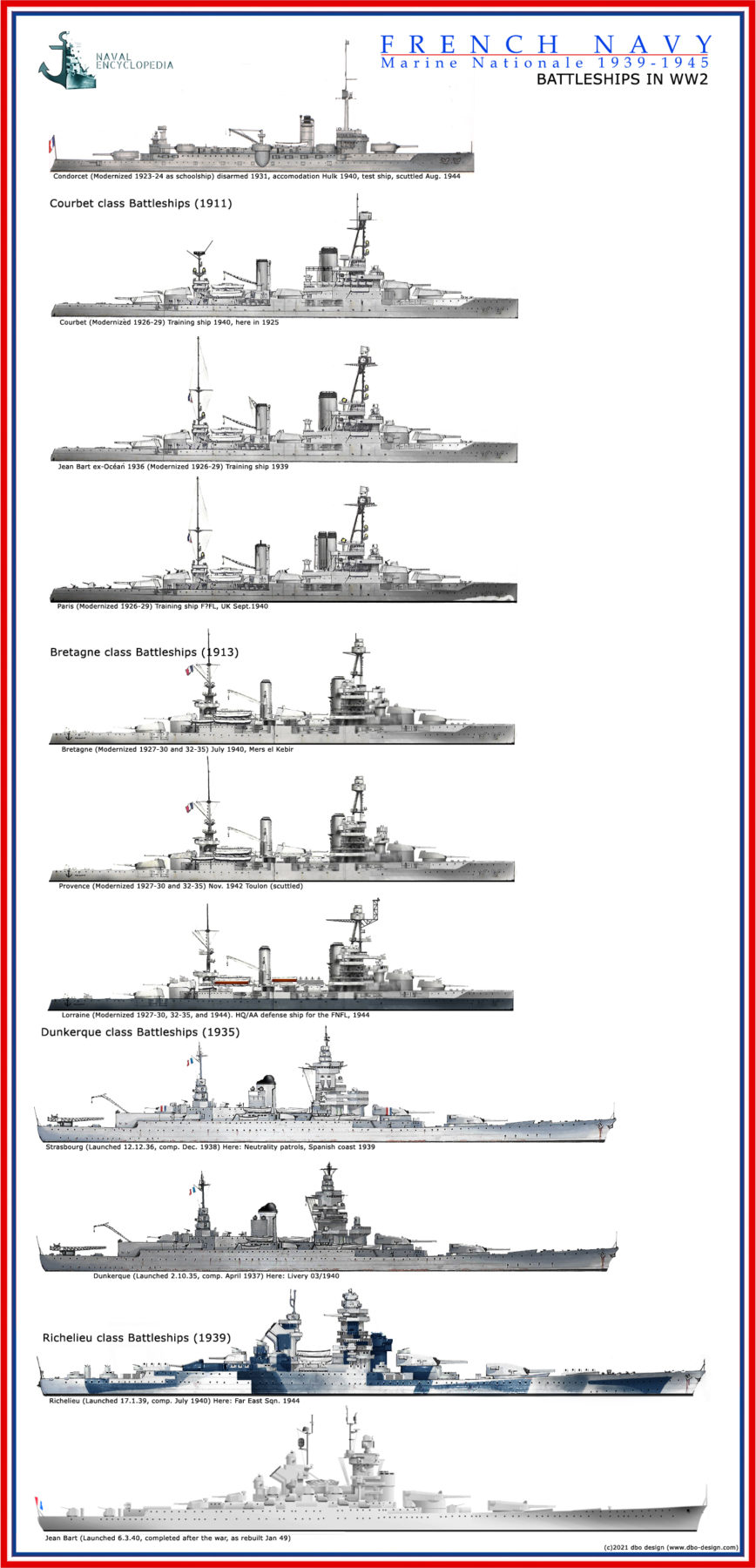
Pagemarker of all the French Battleships in service in 1939, from the old schoolship Condorcet, to the rebuilt Jean Bart in 1950.
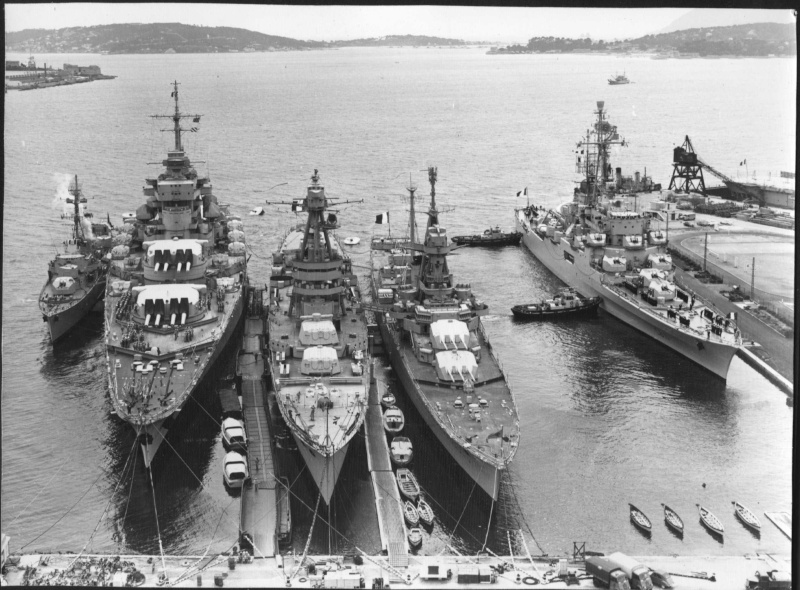
Jean Bart and the cruisers Suffren and Montcalm in the 1960s
This story ended in tragedy in Mers-El Kebir, seeing the Bretagne blewing up, Provence and Dunkerque badly damaged, and Strasbourg escaping though a barrage of fire and magnetic mines. Richelieu was also attacked in Dakar, Jean Bart escaped to North Africa, and others were interned and disarmed. Sadly, the mass scuttling of Toulon in November 1942 completed the destruction, leaving in 1943 only one truly active French battleship, but the most impressive: Richelieu, which after a modernization in the USA went on soldiering in the far east with the Free French Naval Forces and Royal Navy.
This picture only shows the actual use of French battleships, crippled by divided loyalties, but should not occult a rich and innovative design history, with numerous projects in between. France also had in 1954 the rebuilt Jean Bart, the world’s only AA battleship of the cold war, more advanced in many respects than the HMS vanguard or USN battleships still in service during the Korean War. Richelieu for her part is now saluted as one of the best Washington treaty battleships, with a ratio between speed, armament and protection noted better than the Bismarck, and in the top five best battleships ever designed*. Some of her innovations like the “mack” (a combined mast-funnel) became the staple of cold war radar mast/funnel integration.
Part 1: French Dreadnoughts (1909-1922)
Danton class semi-dreadnoughts
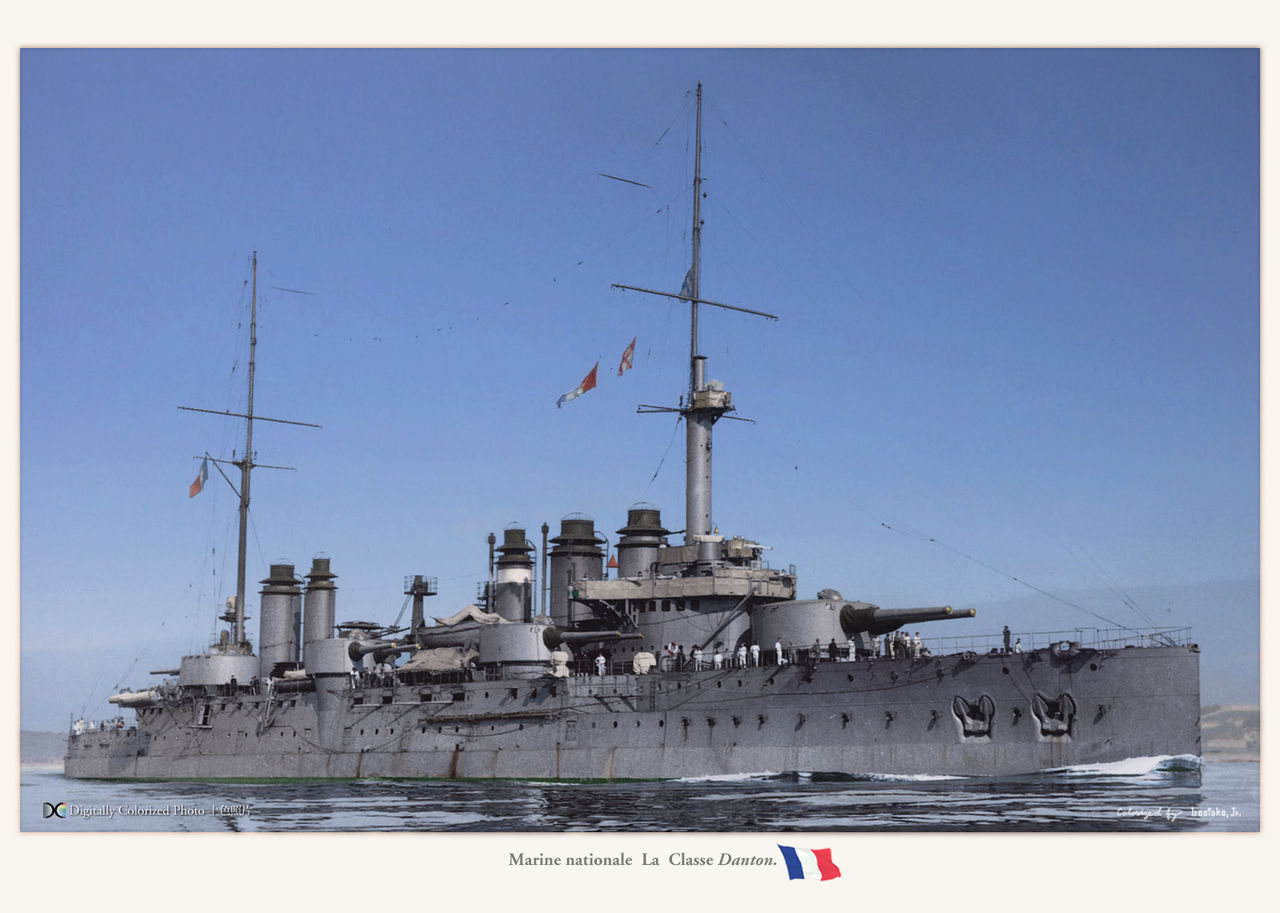
Danton class in WW1, colorized by Irootoko Jr.
The only French semi-dreadnoughts
The last pre-dreadnought French class (about 40 has been built since the 1880s, and France “invented” the concept of ironclad in 1859) was the Danton class battleships. France had the infortune to start well after HMS Dreadnought was launched, on 23 August 1907 when the first was laid down. So why choose to keep the schedule and went on with them ? Because the Danton were in effect already transitional, “semi-dreadnoughts”.
By definition according to naval experts and historians, a semi-dreadnought is a formula keeping a reduced main battery of four guns in twin turrets for and aft (or two single on the Regina Elena), completed by a powerful secondary battery made of 8 inches, up to 10 inches guns. The latter compensated for the lengthy reload time of the first, conceding some range. With its battery of two twin 12-in and twelve 9.4 in in six twin turrets, the six Danton were able to deal on paper some damage on any dreadnought.
They were a compromise, but lacked in speed, with turbines only capable to make the ships approach 19 knots. Moreover they delayed the start of “true” dreadnoughts until 1910. The last of the Danton, Vergnaud, was completed on 18 December 1911, whereas at the same time the Royal Navy seen the near completion of the first of its “super-dreadnought”, HMS Orion. France was only barely catching-up with the Provence in 1916, whereas the British were still a step away with the Queen Elisabeth class and their 15-in guns. Apart USA which stayed close in this race, Germany stayed behind, with the contemporary König still armed with 12-in guns as well as Russia, which never passed this caliber due to the revolution. Japan was also a bit late in this as well as Italy. So as a whole, it was difficult to any Nation to keep up with the Royal Navy, which was thought of and planned since 1905. Why they are in this section you ask ? It’s because while her older sister-ships were all scrapped until 1922, these battleships at least still served actively until 1922 and were converted as schoolships afterwards, surviving for some in WW2.
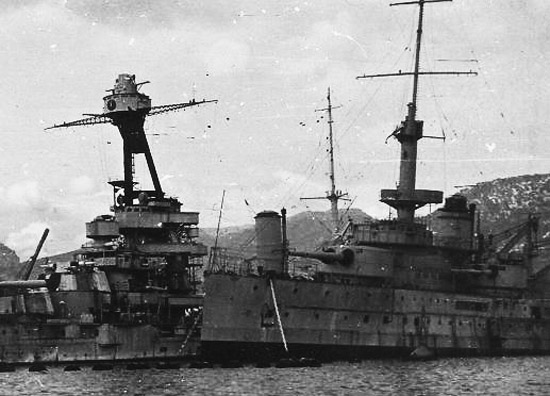

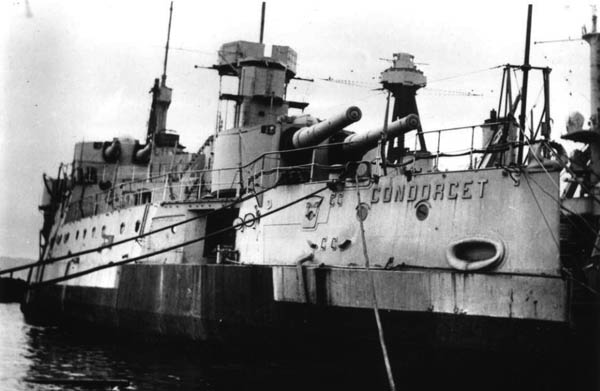
Various photos of the barrack ship Condorcet in Toulon, after the scuttling of 1942. The profile shows its interwar modifications, but she had no propellers nor funnels left at the time, those seen are from the battleship Provence anchored alongside. Ctds: forum.pages14-18.com
Interwar service
In 1922-25, the ASW protection on Condorcet, Diderot, and Voltaire was improved.
–Condorcet is perhaps the most interesting of all. From December 1918 to March 1919, she represented France in the Allied squadron in Fiume, in resolution of the Yugoslav question. She served with the Channel Division of the French Navy, was modernized in 1923–24 concerning her underwater protection like the others, her four aft 75 mm guns were removed and she teamed up with Diderot and Voltaire in the Training Division, Toulon. Condorcet became a schoolship for the torpedo and electrical cadets, showcasing a torpedo tube on the port side, quarterdeck for training. She was partially disarmed in 1931, converted into an accommodation hulk. In 1939 she was still there, and her propellers were removed. Among others, one of her cadets was the future famous underwater explorer Jacques Cousteau which served on board and learned diving from 1936.
In April 1941, Condorcet was towed to sea to evaluating a new propellant, used by Richelieu later at the Battle of Dakar, on 24 September 1940. She was fitted for the occasion by a single, fixed 38-centimetre (15 in) gun similar to those onboard the Richelieu. During the battleship’s tests, there was indeed an explosion in the breech, the investigation thought at the time the propellant was the most likely cause. So Condorcet’s aft turret, which was modified to house this gun, fired several mock shells using remote control. This exonerated the propellant for any harm.
In July 1941, Condorcet modified to house the signal, radio and electrician’s schools. New structured with extra housings were installed at the bases of four funnels, previously removed. Instead, the latest radio equipment were installed to train students. Condorcet at the fall of 1941 was however rammed accidentally by a submarine, Le Glorieux, as she latter was just leaving drydock. It punctured the condorcet’s hull, flooding a compartment. This required a drydock period for repairs. In November 1942 the Germans launched operation Paula, following the North African landings and subsequent swap of Admiral Darlan, in charge of the forces there. Condorcet was not “precious” enough to be scuttled, and was left intact when she was captured by Germans troops. Since it was already fit for this, they used her as a barracks ship until she was practically destroyed by and allied air raid over Toulon in August 1944 (Operation Anvil Dragoon), and scuttled by the Germans. Some of her main guns were unloaded and used in a coastal battery, on the north bank of the Gironde estuary, Bay of Biscay, the same year. They never saw service.
Condorcet was eventually salvaged to be scrapped in September 1945, broken up in 1949.
–Mirabeau was in the Mediterranean after the 30 October 1918 armistice of Mudros, for the Ottoman Army. She participated in the occupation of Constantinople until 12 December. And returned to Toulon in 1919. Modernized in 1922–25, she became a training ship in 1927, and was condemned on 17 March 1937, ten years afterwards, scrapped in August the same year.
–Vergniaud took part in early 1919 in the allied fleet stationed off Sevastopol and when the White Russian’s situation became hopeless, the high command ordered the French ships present to withdraw, but Vice-Admiral JF. Charles Amet refused and send a land party to participate in the fight, which backfired as a bolshevik mutiny onboard, some even unfurling red banners. Later one of these sailors was killed during a mass shooting. The battleship left the black sea.
Vergniaud next was in Beirut in May-August 1919, watching Turkish moves along the coasts of Palestine, Lebanon and Syria. Back in Toulon by September, she was placed in “special reserve” and inspected. It was established that due to her in poor shape, she would be decommissioned in June 1921 and completely disarmed in 1922. Her 240mm guns were reycled in the coastal defence batteries of Dakar, Senegal, and the Île de Gorée. During the battle of the same name, they hit Barham and other British ships trying to assault the port. Vergniaud became a target ship, and poison gases and bombs were tested on her until 1926. Sold on 27 November 1928 for scrap.
–Voltaire has been torpedoed on 10 October off Milos island by UB-48, struck by two torpedoes. She survived and temporary repairs were made in situ, before she sailed to Bizerte for permanent repairs. Back in Toulon in 1919, modernized in 1922–25, she had her underwater protection improved, and became a training ship in 1927. Ten years after she was stricken and scuttled in Quiberon Bay, still above the waves, in order to be used as a permanent, fixed target from May 1938. Eventually what was left of her was sold in December 1949.
Courbet class (1911)
Interwar Modernization:
The three Courbet class battleships were the first dreadnoughts of the French navy. The class included the lead ship Courbet, Paris, Ocean, and France. They actively participated in and survived to the Great War. In 1922, the battleship France sank off Quiberon on an unlisted reef. The other three were extensively modernized in 1926-29. Still, this never reach the level of sophistication of Italian or British reconstructions, mainly due to budget restrictions. By September 1939 they were still very much apparently “in stock condition”. However modifications included their machinery overhaul, funnels truncated into one, with new oil-fired boilers and revised turbines. Two new masts were erected, notably a stronger forward tripod to support a new command tower and new range finders. The communication and electrical systems onboard were also modernized. The main gun mounts were also modified for better elevation, increasing their range. They also received additional AA guns, seven 76 mm (3 in) and two 45 mm (2.5 in). Courbet alone received new turbines, those taken from the stock provided for the unfinished Normandie class, and old design, but better than the original VTE coal only engines. ASW protection was also improved by the addition of longitudinal bulkheads and extra armour strays over the machinery spaces and ammunition storage. But despite of this they had a completely outdated artillery layout and 12-in guns were sub-standard at the time. In 1939, both the AA and associated firing systems were also obsolete. Their role was therefore very reduced in operations and they were kept in the Atlantic, while the better modernized Bretagne took charge of the Mediterranean.
Fate:
–Ocean was renamed Jean Bart in 1936, and partially decommissioned in 1938, acting as a training ship in Toulon. Spared in November 1942 in Toulon, she was later sunk by an allied air raid in August 1944 during operation Operation Anvil Dragoon. The Germans themselves completed the destruction by testing explosives.
–Courbet and Paris were also provisionally transferred as training ships in 1939, but returned to active in the Fifth Squadron (Admiral Mord) in May 1940. Their mission was to attempt to intercept German forces attempting to close in from Cherbourg. They helped evacuating Cherbourg as well as Le Havre, but were criticized for their weak AA defense when attacked. With the Luftwaffe hard on their heels, both took refuge in Portsmouth in June 1940. During Operation Catapult in July 1940, both they were successfully captured by Royal Navy troops and their crews were interned. Later, Courbet was donated back to the FNFL (Free French Navy). Rearmed with more modern AA, she served as a floating HQ and floating AA battery for the FNFL. Paris became a depot ship, partially disarmed and with a skeleton crew. Courbet was decommissioned in 1941 and also used as depot ship at Portsmouth. In 1945, Paris headed for Brest and ended her career as a service vessel, floating barracks, before sold for BU in 1947, as Courbet.
Specifications (Paris 1940)
Displacement: 22,200 t. standard 25,600 t. Full Load
Dimensions: 162 m long, 28 m wide, 7.3 m draft.
Machinery: 4 shafts, 4 Rateau-Bretagne turbines, 9 Guyot Du Temple boilers, 120,000 hp.
Top speed: 21.5 knots.
Armor: Same as WW1 but AS bulkhead and compartmentation
Armament: Same but 7 x 76 mm AA, 2 x 45 mm AA, 6 x 13.2 mm AA, 2 x 21-in TTs sub.
Crew: 850
The Provence class (1913)
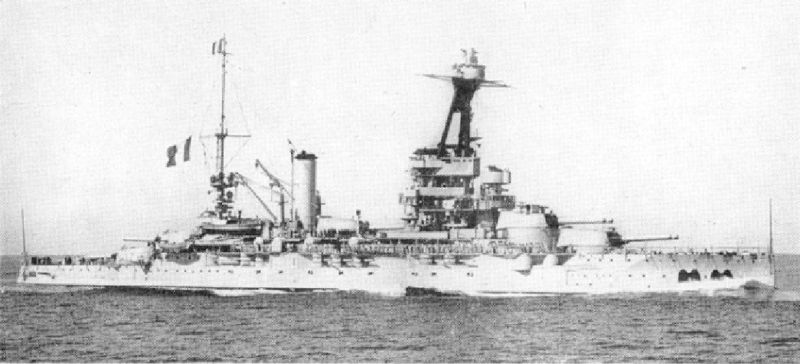
The Battleship Provence in 1935 – ONI recoignition plates, USN Intel
The three battleships of the Bretagne class (Bretagne, Provence, Lorraine), launched in 1913 and completed in 1915-16 were the second series of French Dreadnoughts to emerge. Although based on the same hull, they were given a more modern battery of axial artillery mirroring the Iron Duke class, with ten 340 mm (14 in) guns. Machinery had been improved with new steam turbines but still, running at least partly on coal. The model 1912 main guns turned out to be outstanding pieces of ordnance and they were mass-produced for to be sent on the western front (railway batteries), reliable, rugged and accurate they were also provisioned for the Normandy and Lyon class. The last were captured during the occupation in ww2 and ended in the Atlantic Wall. Initial range was 21,000 meters. An fourth in this class was ordered in 1914 by the Greek Navy, but construction was suspended in August 1914.
Their career was active in the Mediterranean, their main theatre of operation for their whole career. They been designed as the 1st BS division of Toulon, the head of the squadron. After 1918, they underwent a number of modifications, including main gun cradle mounts in order to increase their range in 1921-23. Their reconstruction also implied the replacement of all their coal-fired boilers by more modern oil-fired boilers in 1927-30. In 1932-35 they went into drydock once more to received new superstructures, bridge and tripod, a new fire direction top and rangefinders, and completely modernized secondary anti-aircraft artillery. They also received new 14 inches guns and more powerful ammunitions for higher velocity, their range now was raised to 30,000 meters. Their central casemate armour and bulkheads, ASW protection were also greatly improved. Lorraine operated a seaplane, complete with a hangar, cranes and a catapult in place of her central 340 mm turret. In 1939, if these modernizations were impressive, they were less extensive than Italian and British total conversions.
During the WW2, Bretagne and Provence were part of the Mers-el-Kébir squadron. When Admiral Sommerville’s ultimatum expired the British force opened fire, and the Bretagne, hit in an ammunition storage, exploded and capsized in the harbour, causing a great loss of life. Provence almost suffered the same fate and she sank slowly in the harbour, evacuated by her crew. Later in 1941 she would be refloated and towed to Toulon for permanent repairs. Provence returned into service in 1942, but was scuttled in November with the rest of the fleet. Lorraine on her side, was in Alexandria during operation “Catapult”. Thanks to the diligence of both admirals to avoid a bloodshed and agreement was found in which she was partially disarmed and interned until 1943. After joining the FNFL, she received modifications in NY NyD, radar and modern AA to the allied standard. She subsequently served in the Mediterranean, notably covering the landings in Provence (Operation Anvil Dragoon). From 1945 to 1953, Lorraine served as a training ship and was decommissioned and converted into a depot ship before being scrapped.
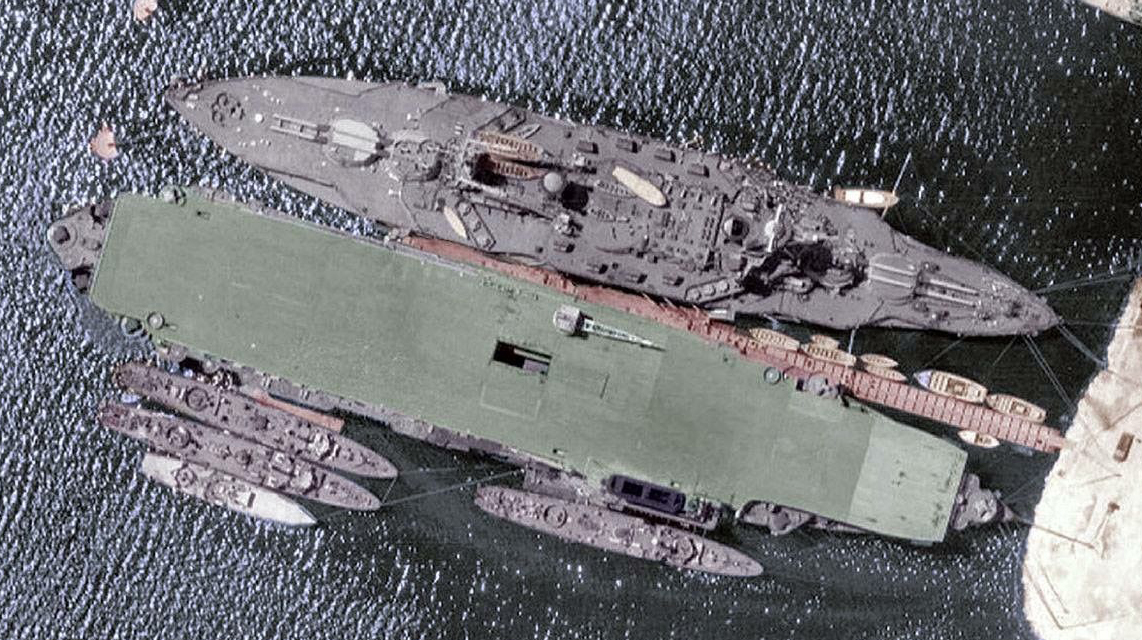
Aerial view of the Lorraine, alongside the carrier Béarn in Toulon (from pinterest, date unknown)
Specifications (1939)
Displacement: 23,230 t. standard -25,200 t. FL
Dimensions: 166 m x 28 m x 9.8 m.
Machinery: 4 shafts Parsons turbines, 12 Guyot Du Temple boilers, 29,000 hp.
Performances: Top speed: 20 knots
Armor protection: Belt 270 mm, Barbettes 170 mm, Deck 40, Turrets 340 mm, CT 314 mm.
Armament: 10 x 340, 4×2 100 mm AA, 4×2 37 mm AA, 6×2 13,2 mm AA, 2 TTs.
Crew: 1130
Normandie & Lyon class (1915-17)
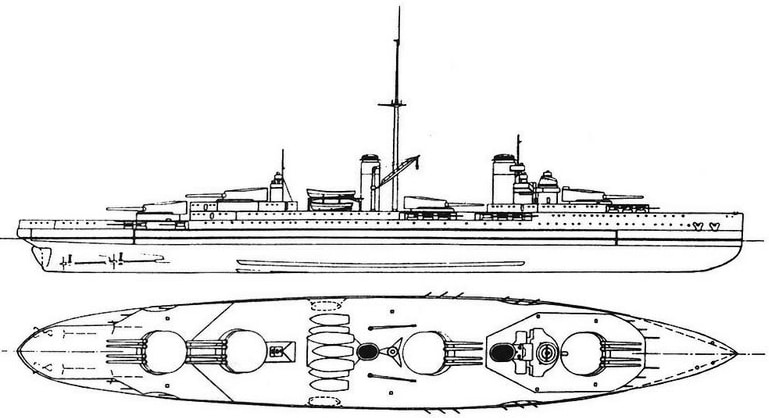
These classes already had been covered in detail in the WW1 French Battleship article. The four Normandie class were cancelled after launch and scrapped, Béarn was chosen for a conversion as an aircraft carrier. The Lyon class remained on paper stage only. Guns and machinery were reused in modernizations of the earlier dreadnoughts. The best merit of both classes would have been to introduce quad turrets, which became the standard for French Battleship design during the interwar. Battleships were also planned in 1912, but they were left at paper stage only, read more about these in the dedicated article on Durant-Viel projects.
Post-Washington projects
The signing by France of the Washington treaty in 1922 had drastic consequences: Their first victims were the Normandie class, which could replace advantageously the Courbet class. But that would have signified deactivating the already existing four Courbet class while completion of their replacement was still far ahead, and due to the wartime interruption and probable redesigns due to wartime lessons (like improving vertical armour), revision in AA as well, pushing their completion date to 1922 at the earnest, and at great cost. But France was near-banrkupt at this point and maintaining the Courbet class was a way safer option. What could be “recycled” from the Normandie class was, from the machinery to the guns and Béarn was entirely rebuilt as France’s first aircraft carrier. The Lyon class design, completed after 1925 would not have been a wise option as the 1913 design needed a complete revision, which were done in the 1920s proposals to “fill up” the Washington treaty tonnage by testing various tonnage and feature options. Since the trend in 1922 was already to a fusion of the fast battleship and battlecruiser roles, the concept of battlecruiser was dropped in favor of intermediate designs, culminating with the Dunkerque class in 1930.
The Dunkerque class (1932)
The ships of the Dunkerque class, with her sister-ship Strasbourg, were the first French fast battleships, and first capital ships launched since 1915. Following the Washington treaty, and the Treaty of London (1931), the Marine Nationale explored many designs to take the best advantage of the tonnage allocated, making compromises to allow more ships with the best possible features. This ling process started in the 1920s ended in strange vessels, which were not true battleships, neither battle cruisers as protection was not entirely sacrificed to speed. Basically they were somewhere between the two. They also answered directly to the threat of “pocket battleships” of the German Deutschland class, and hunt them down. For the design, the solution already planned for the Normandie and Lyon was chosen, of quadruple turrets. The solution, unique to France, maximized protection of vital related to artillery, notably just two barbettes instead of three or four and less ammunition storage rooms. The weight of these turrets was not negligible, and in the light of new tactical developments that led to the Nelsons and G3 in UK, it favored forward-firing. Critism fell however on this choice over the question that a single hit could disable an entire turret and thus, delete half of the ship’s firepower at once. This was addressed on the next Richelieu, which internal turrets were subdivided into two compartments separated by a thick bulkhead, making a collage of two twin turrets in reality.
These ships were the first of the new serie of fast battlesips built at the eve of WW2 and during it. Germany in response designe the Scharnhorst class while Italy announced the construction of the Littorrio, with arguably a better armor while the Germans were more favourable to a better speed. As a result, the French already started to plan for the next class, the Richelieu. The two Dunkerque were the result of a reflection on the usefulness of battleships, based on little knowledge could be gained after the battle of Jutland. Defense of trade routes of the wide French Empire seemed paramount, so cruisers were better suited for this task. These ships were therefore tailored for this purpose. Even after the release of the heavier Scharnhorst class, their artillery and armor remained roughly adequate. The Dunkerque was launched in 1935 and her sister ship Strasbourg in 1936. They were operational in 1936-37, patrolling during the Spanish civil war.

Their peacetime careers comprised intensive squadron exercise, and they were based in Toulon, regularly anchored in bases in Africa like Mers-El Kebir. When WW2 broke up, the two ships operated with the Force de Raid against German raiders in the South Atlantic, notably the Graf Spee, and protecting merchant traffic. In December 1939, Dunkerque took the gold reserves of the Bank of France to Canada. The force de raid based in Brest, completed with heavy cruisers and destroyers, was transferred to the Mediterranean in the light of the changing attitude of Italy in June 1940, and were based at Mers el Kebir. Both were attacked by the Royal Navy during Operation Catapult in August. Strasbourg was able to escape though, chased for a time by the Hood and attacked by planes from the Ark Royal. She managed to sail to Toulon. Dunkerque had been hit by four 15-in direct hits, destroying in particular hr whole electrical installation. She was towed across the harbor and later attacked by Swordfish torpedo bombers, and sank after a barge moored alongside exploded. She refloated later, towed to Toulon for repairs, but both battleships were scuttled in November 1942.
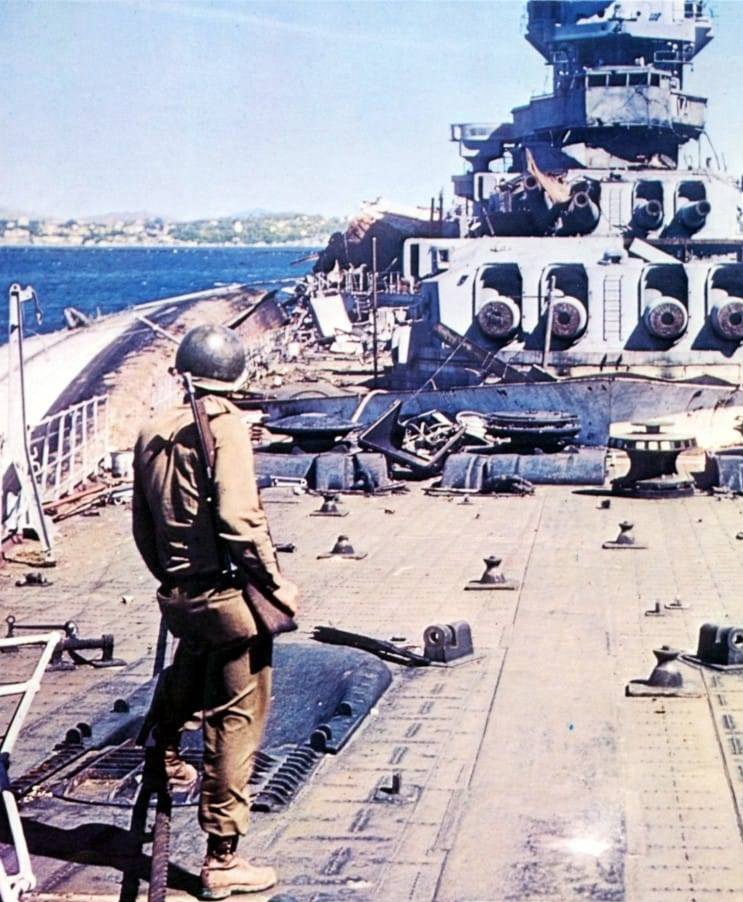
A GI examining Srasbourg in Toulon, circa September 1944, after the city was taken by allied forces following the landings in Provence.
Specifications
Displacement: 26,500 t. standard 36,380 t. Full Load
Dimensions: 215.10 m x 31.10 x 8.7 m draft.
Machinery: 4 shaft Rateau-Bretagne turbines, 6 Indret boilers, 135,600 hp.
Top speed: 31 knots.
Armor: 225-280 mm belt, 30 mm bulkheads, 115-137 decks, 330-360 mm turrets, 330 mm CT.
Armament: 8 x 330 mm, 3×4+2×2 135 mm DP, 5×2 37 mm AA, 8x 13.2 mm AA, 4 Loire 130 seaplanes.
Crew: 1380
Richelieu class (1939)
Given in response to the German Scharnhorst and Italian Littorio, the two Richelieu class retake most of the previous design, but incorporated a much more powerful machinery and above all integrated a significantly superior armor. They were in fact the first real French “fast battleships”. In addition to their new bow cut clean and supposed to improve its penetration, it also had a unique “mack”, configuration which became commonplace in the cold war. By concentrating superstructures in the center, and the turrets, with a smaller space than classic battleship, weight-savings made it possible to rationalize even more the overall protection. Their ASW protection was further refined and even better. They only barely met the standards of the Washington Treaty, but were also very fast, in fact the fastest battleships afloat before the Iowa class in 1943.
The longer ships allowed to separate even more the two forward turrets, which were subdivided into two twin guns compartments for further protection. The front configuration was still inherited from the simple tactical “crossing the t” tactic, to create the smallest possible silhouette while having the whole artillery to bear. Interior sub-divisions had been carefully designed to minimize effects of a direct impact. The secondary armament consisted of a uniform battery of three triple turrets armed with rapid-fire 6-in guns (152 mm), dual-purpose and semi-automated. Their high incidence provided a long range anti-aircraft cover, but without their specific fire control system, never installed in time, they were slow and practically useless for this.
The secondary AA was more effective while on the other hand still weak in 1937, not to mention the tertiary AA composed of heavy machine guns in single and quadruple mounts. The 37 mm twin mounts proved effective, but there were too few of them. After WW2 broke out, this configuration was very quickly judged ineffective. The reconfiguration of the Richelieu was made in 1943 and outside the british radars which equipped her, her AA armament was entirely based on US Navy standards. Thanks to her large size, she was able to host a very large quantity of 20 mm and 40 mm AA guns, showed her effectiveness as an AA escort, especially in the fasr east where she was deployed. Shortly after she was laid down, the Italians announced the construction of second pair of improved Litorrios, starting with the Vittorio Veneto and Impero (only the first was completed). As a result, in 1938 France voted to build two sister ships to the Richelieu class, called the Gascogne class (see later) and another pair in the 1940s, armed with larger guns.
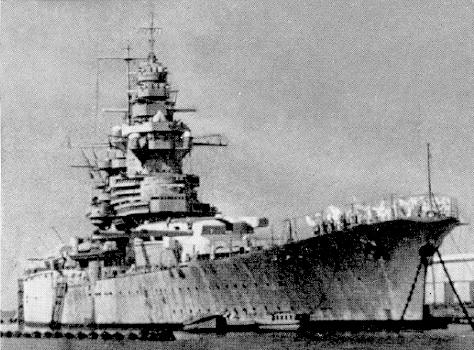
Richelieu in Dakar
Richelieu, launched in January 1939, was not yet ready in June 1940, about 95% completed. Her tests took place in April 1940 and she left Brest hastily in front of the German advance, with too few main guns rounds and just enough fuel oil to reach Dakar. She arrived here on June 23, escorted by destroyers Fronde and Le Fier after a stop in Casablanca at the time of the armistice. During the operation catapult operation in July 1940, swordfish from HMS Hermes attempted to damage her with depth charges, failed but this was followed by a Swordfish torpedo attack, actually managing to hit Richelieu. Flooded she sank slowly to the bottom, but still emerging, so combat capable. After some repairs and water pumped out, she was towed to a less exposed part of Dakar harbor. The squadron was later reinforced by the cruisers Georges Leygues and Montcalm. On September 24, the Battle of Dakar took place. This raid by a Naval British force also carried Free french, led by De Gaulle. Their hope was to negociate a swap of allegiance, bringing these ships to Free France, but it was a failure, underestimating the loyalty to Vichy and hate for the british after Mers el Kebir. During this event, Richelieu exchanged fire with Barham and another battleship, both being hit by coastal fire and a submarine attack.
In 1941, Richelieu was refloated, completely repaired and her equipment completed in Casablanca, notably additional AA, a radar, while its on-board aviation, hangars, catapults and equipment were unloaded. She returned to Dakar. After Operation Torch Admiral Darlan agreed to turn to the side of the allies, and the remaining ships in North Africa joined the FNFL (Free French Navy).
Richelieu left Dakar in January 1943 for Puget Sund in New York. Her conversion to allied standard was completed in October 1943. She had no less than forty eight 20 mm guns in single mounts and forteen quadruple 40 mm batteries. In November, Richelieu joined Scapa Flow and was integrated into the Home Fleet. She thus participated in convoy escort missions, to Murmansk. From April 1944, she joined the Trincomanlee squadron in the Far East, integrated into Task-Force 65. She actively participated in Operation Cockpit against Sabang and Operation Transom against Surabaya, then operation Concillor and Operation Pedal in June 1944, and Operation Crimson against Sumatra. She was relieved by HMS Howe, and set sail for Toulon, then Casablanca, and finally Gibraltar for a refit, lating until October 1944. In March 1945, she was back at Trincomanlee, participating in a second operation against Sabang and the Nicobar islands with Task Force 63. Refitted in Durban, she set sail for Diego-Suarez, anchored there when hearing about the Japanese surrender. She then participated in the liberation of Singapore but was later damaged by a magnetic mine in the Strait of Malacca. After repairs in Singapore, she returned to Toulon, carrying troops to Indochina.
In 1946 she was back in Toulon, spending of her carrer in squadron exercises, notably with Jean Bart completed in 1956. She was partially re-equipped on this occasion with moren radars, fire controls and more modern mounts for her main guns. Placed in reserve in Brest in 1958, she was condemned in 1968 ad BU in Italy.
Jean Bart:
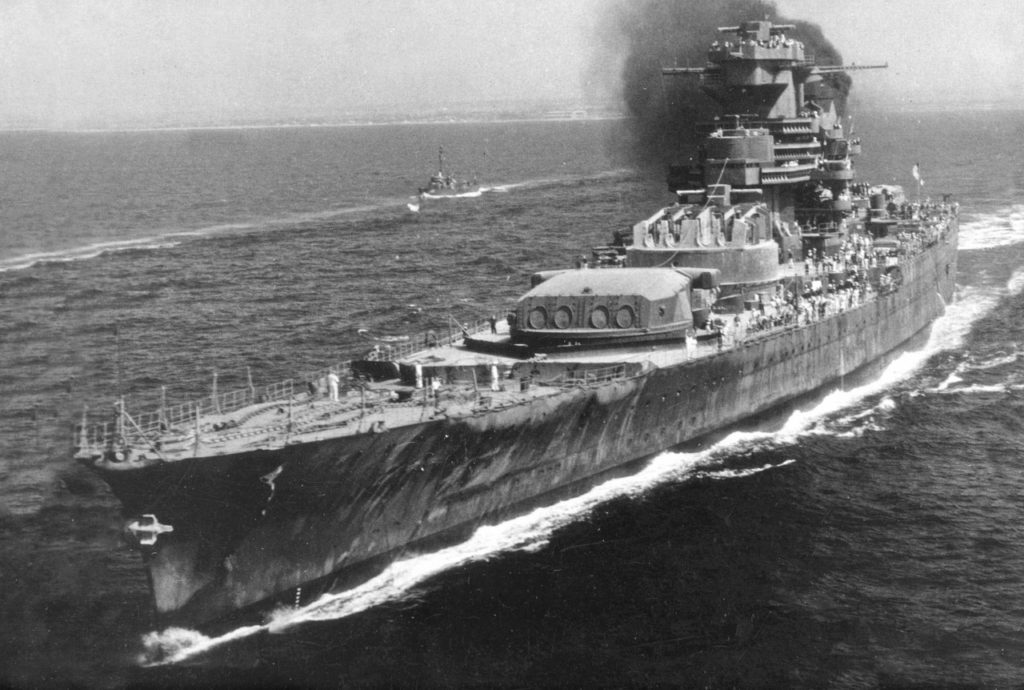
Jean Bart escaping her drydock to North Africa to avoid capture in May 1940. Notice the A turret lacked guns and B turret lack the upper part of her turret. Only gun cradles were in place.
Second battleship of the Richelieu class, the unfortunate vessel had been launched on March 6, 1940. Although completion work was well underway, it was far from being completed in June, something like 70%. She was therefore in Saint Nazaire when her captain, Lieutenant Ronarc’h, decided to set sail (her machines never worked before) to Casablanca in Morocco, to avoid capture by the advancing wehrmacht. She was followed by a cargo carrying all the parts to complete her second turret on board, but she was sunk by an U-Boat underway. Her navigation, control and AA equipment stayed in France, a good part of her electrical network and other equipment. Nevertheless, the crossing (which was a feat in itself) was a success, and Jean Bart arrived in Casablanca to be anchored there, protected by ASW nets and surrounded by AA batteries, waiting for equipments to arrive and hopefully some completion in 1941 or 1942.
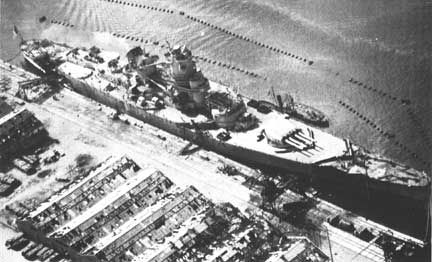
Jean Bart in Casabianca in 1943 – only her “A” operational turret, duelled with USS Massachusetts in November 1942.
Jean Bar was officially under the responsibility of the Vichy government. Completion work continued slowly, while materials and manpower were lacking. During Operation Torch in November 1942, Jean Bart constituted a threat for the allies at the same title of coastal batteries, and was attacked by USS Ranger aviation, but Jean Bart opened fire with her sol working turret “A” on the invasion fleet. Soon, USS Massachusetts adjusted her fire and and Jean Bart duelled for some time until A turret was silenced for good. She took several 16-in shells and aircraft bombs, and thought to have been silences. However on November 10, just two days later, Jean Bart opened fire on the cruiser USS Augusta, to the great surprise of the landing forces. She was hit again by a wave from USS Ranger, some hits piercing her hull,and she sank in shallow water, definitively out of action. After Darlan’s shifted to the allied side, there was a brief study to refloat and repair her and then bring her to the USA to undergo a completion with US systems, but this project never materialized. The war ended in Europe, and in 1945 she was towed to Toulon, and completed in 1949 under a new design, as an AA battleship with modern electronic equipment. Her cold war career was short as after the Suez affair in 1956 and some period as flagship and schoolship, she was costly to operate and was withdrawn from service in 1961, BU in 1968.
Specifications
Displacement: 35,500 t. standard 48,950 t. Fully Loaded
Dimensions: 248 m x 35 m x 9.6 m.
Machinery: 4 shafts Parsons turbines, 6 Indret boilers, 150,000 hp.
Top speed: 32,5 knots.
Armor: 225-280 mm belt, 30 mm bulkheads, 115-137 mm decks, 330-360 mm turrets, 330 mm CT.
Armament: 8 x 380 mm, 3×3 x 135 mm DP, 4×2 x 100 mm AA, 4×2 37 mm AA, 2×4 13.2 mm AA, 4 Loire 130 seaplanes.
Crew: 1380
Gascogne class (1941)

In addition to the Richelieu class fast battleships, two other sister ships planned for the next phase, according to the B3 specification of 1938. They were planned when the shipyard’s drydocks holds would be free (so after Jean Bart was out), before proceeding. Technically, they were close sister-ships, but in the last approved plan, the second quadruple turret was placed aft, to give back a real firing capacity in retreat, accompanied by a replacement of secondary artillery in the front. These drawings were judged to be more balanced, corresponded to the changes and lessons learned from the first squadron exercises, no longer giving priority to forward firing. Their on-board seaplanes facilities were moved to the center and it was planned to equip them with with radars and the same unique “funnel-mast” sparing space. Their artillery was almost unchanged, with eight 380 mm, twelve 152 mm in three triple DP turrets, a secondary battery made up in particular of 100 mm four twin mounts and also six twin 37 mm (6) plus six quadruple 13.2 mm HMGs. With larger dimensions 252 meters overall versus 248) and 51,000 tonnes fully loaded, this class no longer respected the Washington treaty, and comprised Gascoigne and Alsace, but remained at the drawing board stage.
Specifications (planned)
Displacement: 35,500 t. standard -48,950 t. Full Load
Dimensions: 252 m x 35 m wide, 9.6 m draft.
Machinery: 4 shafts Parsons turbines, 6 Indret boilers, 150,000 hp.
Top speed: 32 knots.
Armor: 225-280 mm belt, 30 mm ASW bulkheads, 115-137 decks, 330-360 mm turrets, 330 mm CT.
Armament: 2×4 380 mm, 3×3 135 mm DP, 4×2 100 mm AA, 6×2 37 mm AA, 2×4 13.2 mm AA, 4 Loire 130 seaplanes.
Crew: 1380
Other French battleship classes (1944)
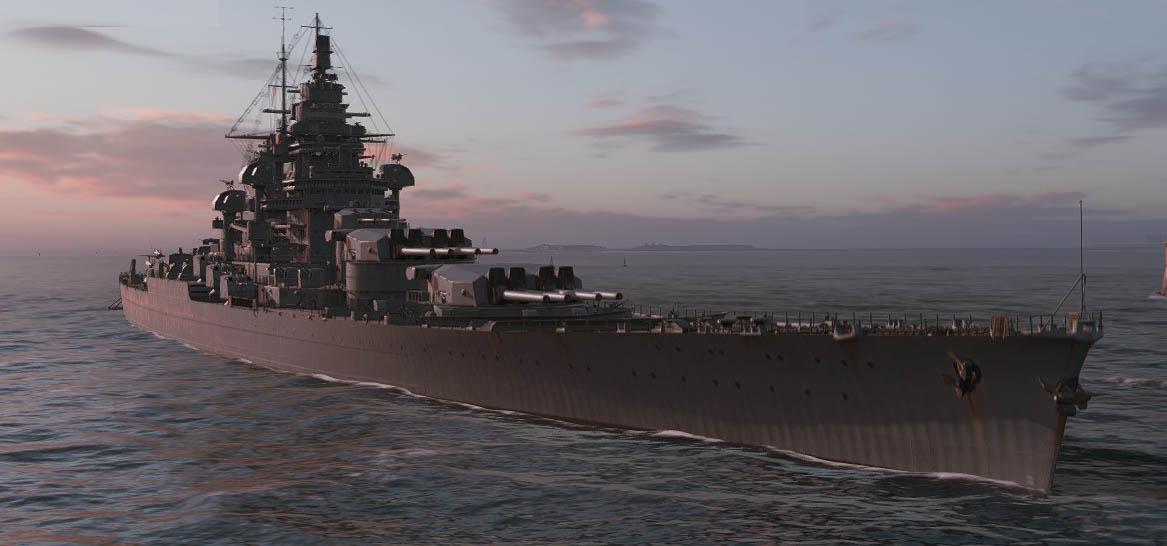
The battleship “Alsace” (Planned 1940)
The Alsace class was supposed to be a response to the construction of the German “H” class battleships and a development of the Richelieu/Gascoigne classes, but with a more powerful artillery arranged in less radical scheme, with twelve 380 mm guns in three main turrets, including two forward. This triple turret arrangement was the staple of fast battleships of that era.
World of warships’s République class, is made up, but is allegedly a version planned in 1939 for the post-war period with a powerful AA and a two quadruple 431 mm main battery, which is difficult to assert. At first assumed to be a fake, as there is no trace of such developments in Conways, most French author’s literature. Now, the “431 mm modèle 1939” was however mentioned in the naval gun board of Ruelle. In this document there was discussion was about the barrel liner, indicating a matching gun design. It is mentioned in a single French forum entry dating back from 2016 (WoW EU), or naweaps.org forum, and mentions of a document in the Châtellerault archives with limited access. The contents list indeed a Calibre 431 mm on page 51, listing both the Canon de 431 mm modèle 1939 barrel and Chemise modèle 1939, 431 mm modèle 1939 (liner). However, since the second Gascoigne class would have been completed at best in 1943 if the war did not took place, and due to the time needed to develop a new gun, that pushed the launching of any battleship based around this gun to at least 1946, for a commission in 1947-48.
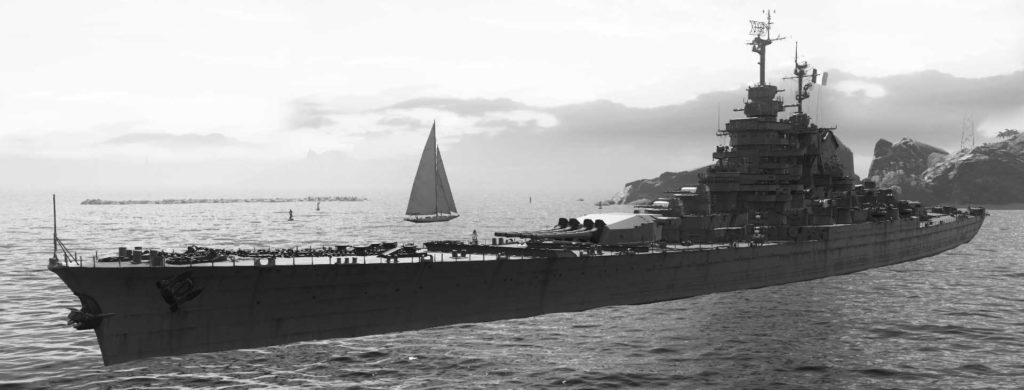
The “Republique”, a 430 mm guns project for at least 1945
As a conclusion, the capital ships development in the French Navy for the interwar period were capped by treaties, but also also limited budget, in the immediate post-war era, and later consequences of the 1929 crisis, a powerful internal peace movement leading to political opposition to navy spendings, or the limited threat represented by the Versailles-bound German navy in a future conflict. The needs of the Empire were to be covered by cruisers, and following a gentleman’s agreement with Britain, the best capital ships were based in the Mediterranean. All contributed to a state in which the French Navy aligned six relatively obsolete battleships with limited modernization: Two fast battleships that lacked armor to risk a confrontation with anything built in 1940-42, and two excellent ones, which were caught by the start of WW2 and disastrous land defeat, and subsequent armistice. In 1943, between destructions, scuttling and inactivations (like the surviving Lorraine), the Free French Navy was limited to a single, active, modern ship, the Richelieu, which is something of a redeeming “happy end” to the whole story.


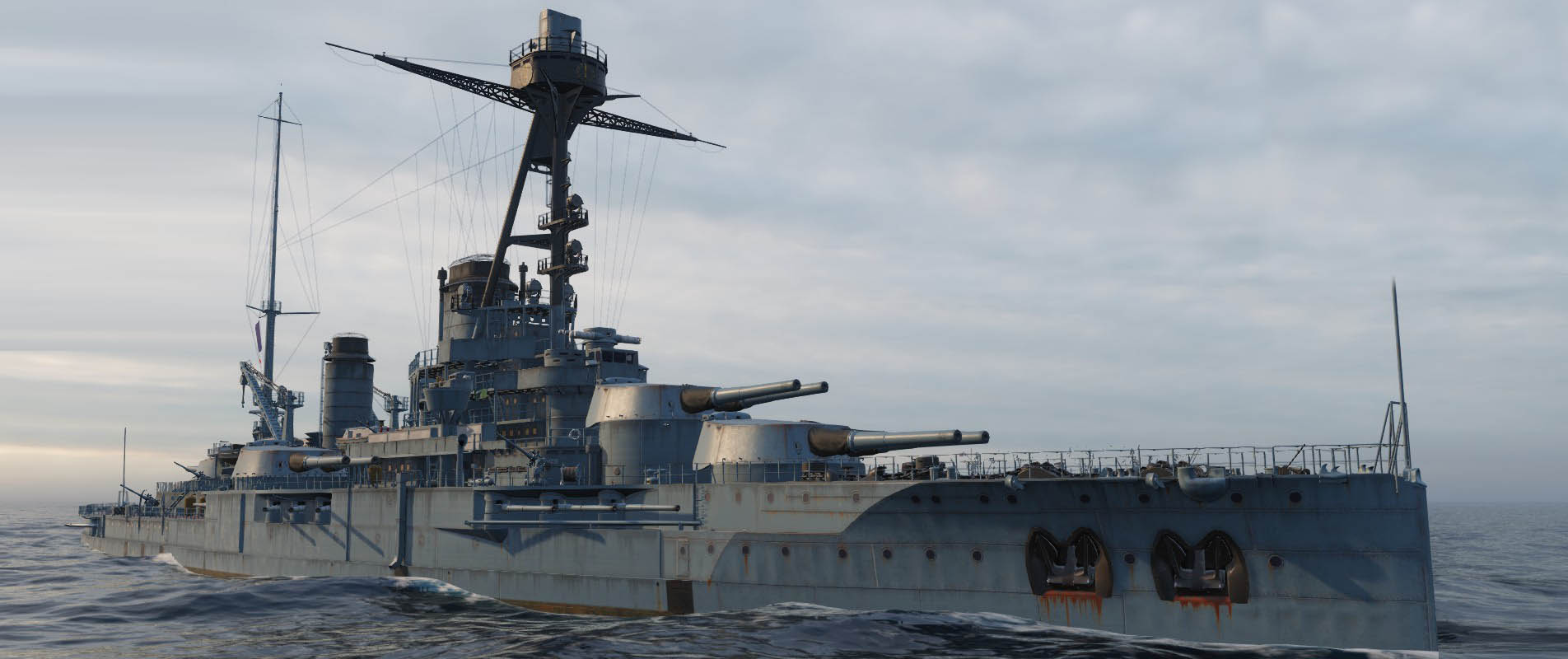
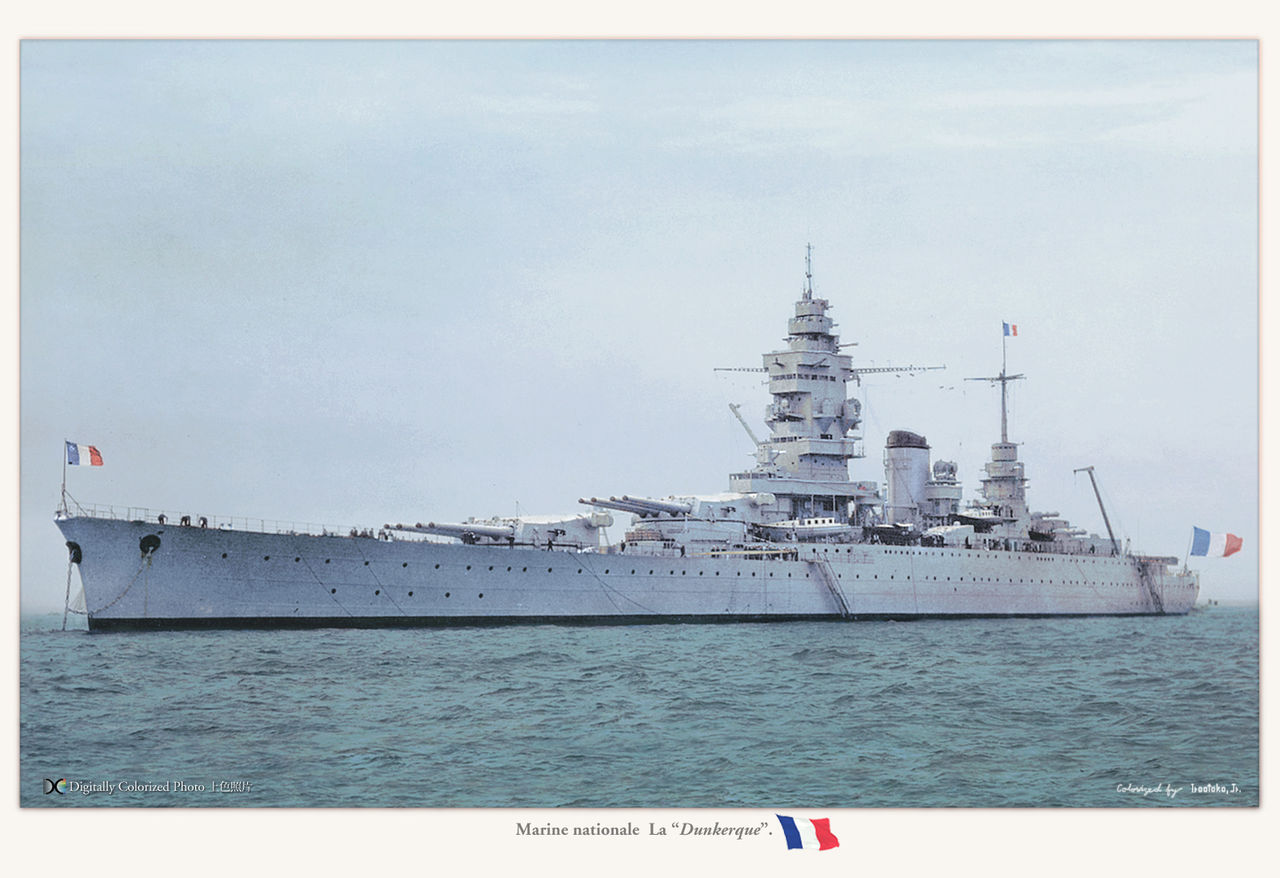
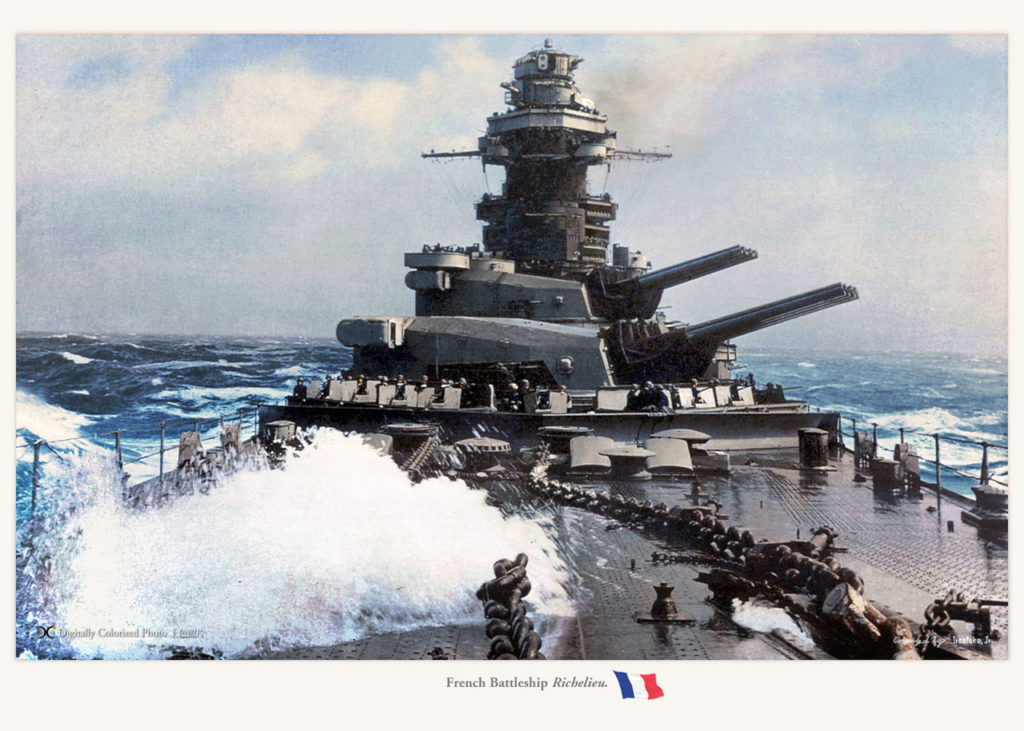
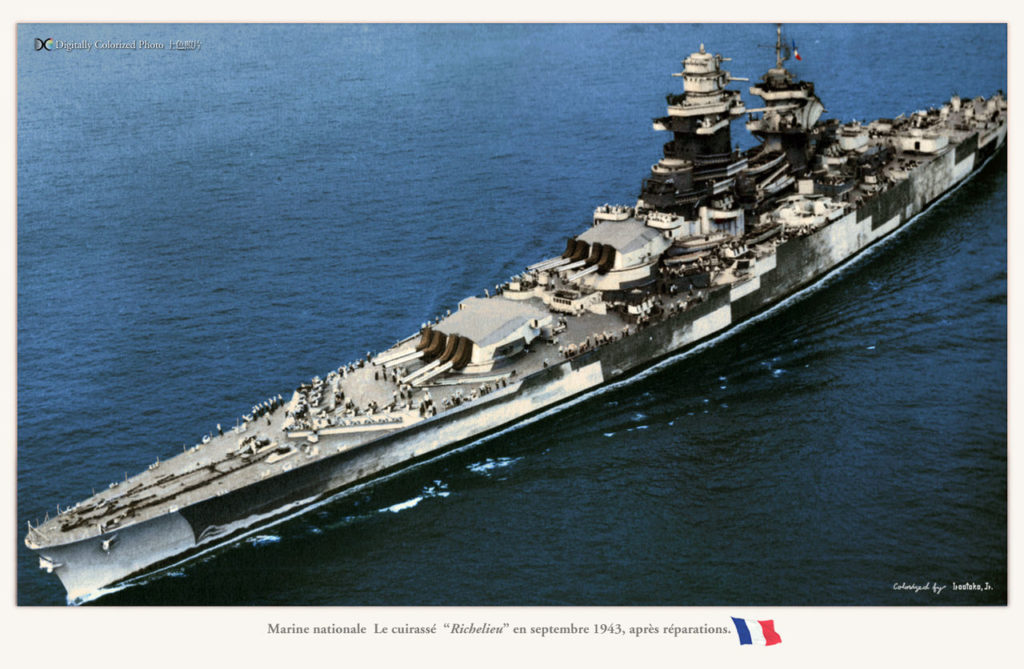
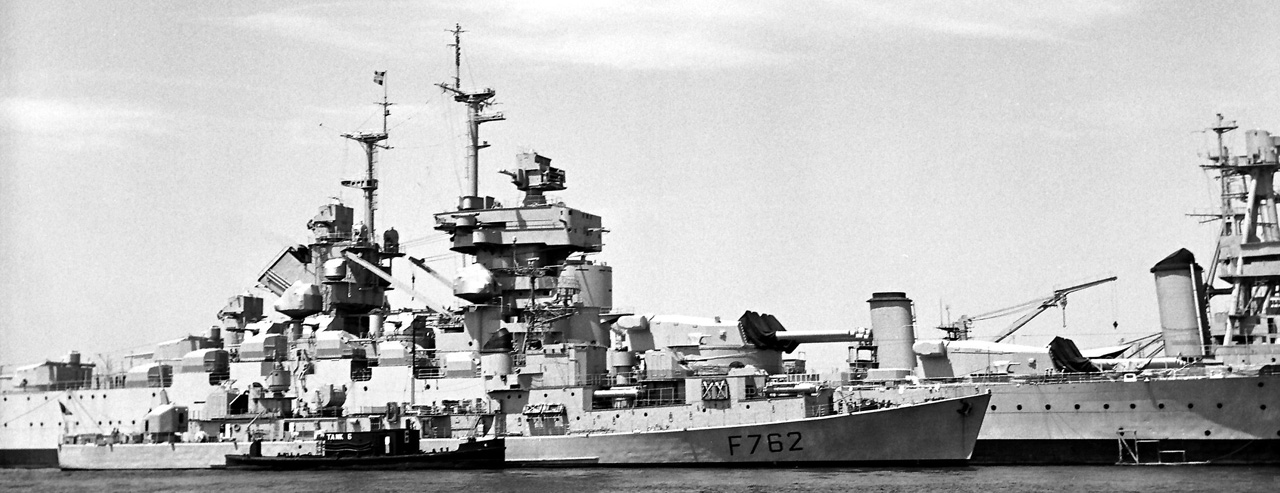
 Latest Facebook Entry -
Latest Facebook Entry -  X(Tweeter) Naval Encyclopedia's deck archive
X(Tweeter) Naval Encyclopedia's deck archive Instagram (@navalencyc)
Instagram (@navalencyc)





 French Navy
French Navy Royal Navy
Royal Navy Russian Navy
Russian Navy Armada Espanola
Armada Espanola Austrian Navy
Austrian Navy K.u.K. Kriegsmarine
K.u.K. Kriegsmarine Dansk Marine
Dansk Marine Nautiko Hellenon
Nautiko Hellenon Koninklije Marine 1870
Koninklije Marine 1870 Marinha do Brasil
Marinha do Brasil Osmanlı Donanması
Osmanlı Donanması Marina Do Peru
Marina Do Peru Marinha do Portugal
Marinha do Portugal Regia Marina 1870
Regia Marina 1870 Nihhon Kaigun 1870
Nihhon Kaigun 1870 Preußische Marine 1870
Preußische Marine 1870 Russkiy Flot 1870
Russkiy Flot 1870 Svenska marinen
Svenska marinen Søværnet
Søværnet Union Navy
Union Navy Confederate Navy
Confederate Navy Armada de Argentina
Armada de Argentina Imperial Chinese Navy
Imperial Chinese Navy Marinha do Portugal
Marinha do Portugal Mexico
Mexico Kaiserliche Marine
Kaiserliche Marine 1898 US Navy
1898 US Navy Sovietskiy Flot
Sovietskiy Flot Royal Canadian Navy
Royal Canadian Navy Royal Australian Navy
Royal Australian Navy RNZN Fleet
RNZN Fleet Chinese Navy 1937
Chinese Navy 1937 Kriegsmarine
Kriegsmarine Chilean Navy
Chilean Navy Danish Navy
Danish Navy Finnish Navy
Finnish Navy Hellenic Navy
Hellenic Navy Polish Navy
Polish Navy Romanian Navy
Romanian Navy Turkish Navy
Turkish Navy Royal Yugoslav Navy
Royal Yugoslav Navy Royal Thai Navy
Royal Thai Navy Minor Navies
Minor Navies Albania
Albania Austria
Austria Belgium
Belgium Columbia
Columbia Costa Rica
Costa Rica Cuba
Cuba Czechoslovakia
Czechoslovakia Dominican Republic
Dominican Republic Haiti
Haiti Hungary
Hungary Honduras
Honduras Estonia
Estonia Iceland
Iceland Eire
Eire Equador
Equador Iran
Iran Iraq
Iraq Latvia
Latvia Liberia
Liberia Lithuania
Lithuania Mandchukuo
Mandchukuo Morocco
Morocco Nicaragua
Nicaragua Persia
Persia San Salvador
San Salvador Sarawak
Sarawak Uruguay
Uruguay Venezuela
Venezuela Zanzibar
Zanzibar Warsaw Pact Navies
Warsaw Pact Navies Bulgaria
Bulgaria Hungary
Hungary

 Bundesmarine
Bundesmarine Dutch Navy
Dutch Navy Hellenic Navy
Hellenic Navy Marina Militare
Marina Militare Yugoslav Navy
Yugoslav Navy Chinese Navy
Chinese Navy Indian Navy
Indian Navy Indonesian Navy
Indonesian Navy JMSDF
JMSDF North Korean Navy
North Korean Navy Pakistani Navy
Pakistani Navy Philippines Navy
Philippines Navy ROKN
ROKN Rep. of Singapore Navy
Rep. of Singapore Navy Taiwanese Navy
Taiwanese Navy IDF Navy
IDF Navy Saudi Navy
Saudi Navy Royal New Zealand Navy
Royal New Zealand Navy Egyptian Navy
Egyptian Navy South African Navy
South African Navy






























 Ukrainian Navy
Ukrainian Navy dbodesign
dbodesign
Thank you for a very interesting item. Some years ago I was able to obtain all 4 of the Heller models of the last 4 French capital ships. My favorite of the 4 is the Richelieu, painted in a scheme worn while in the Far East. Once, while bored, I counted the A/A guns. They were over 100!
Hello Terence, indeed, had this one too when i was a kid. By that time i had no idea of the history of this ship and believed all this AA was original. I’m currently experimenting with 3 printing 1/72 subs to see if it’s worth starting a business. Progress had been made, notably with resin, it’s impressive.
David
The caption of your picture of the American soldier on the scuttled battleship Strassbourg on the https://naval-encyclopedia.com/ww2/france/french-battleships.php should be “September 1944 instead of September 1942.
Joe Molyson
Fixed, thx !